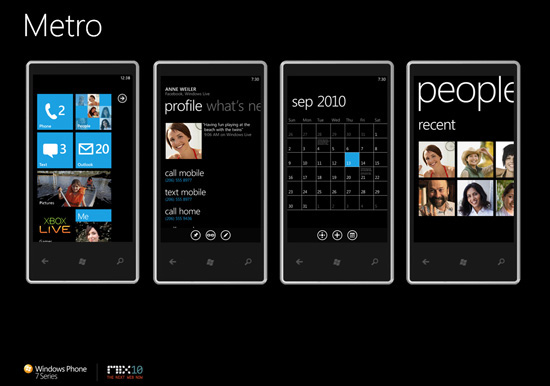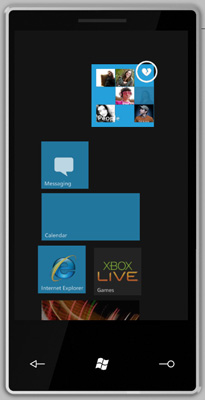Windows Phone 7: The AnandTech Guide
by Brian Klug on March 21, 2010 12:00 AM EST- Posted in
- Smartphones
- Windows Phone 7
- Mobile
Recapitulation
Microsoft MIX 2010 has drawn to a close, and with it comes our concluding wrap-up of everything that there is to discuss about Windows Phone 7 Series (henceforth WP7S).
Let's start at the beginning - WP7S does away completely with everything Windows Mobile. That means Windows Mobile applications won't run on WP7S, hardware running Windows Mobile won't run WP7S (including HTC's HD2), and Windows Mobile is no longer being actively developed. Existing hardware will get support for corporate clients, and the developer tools will remain, but they won't be actively developed. Consider Windows Mobile officially banished from the Microsoft kingdom, and you get the perspective. To give you an example of just how banished Windows Mobile is, there was virtually no discussion of porting applications from Windows Mobile to WP7S - this is a completely different platform. Microsoft wants developers to forget about Windows Mobile and immediately start thinking WP7S. The sense of urgency is because Windows Phone 7 Series will ship before the end of the year ("Holiday 2010").
Microsoft has tossed out the Windows CE-derived, aging UI of Windows Mobile. In its place, it has created a typographically-driven "user experience" that takes taken nods from Windows Media Center, the Xbox Dashboard, Zune HD interface, and urban signage. It calls this style "metro."

Metro - "It's about content and typography"
Instead of standalone application icons, WP7S uses "tiles." In practice, these are almost the same thing, except developers can both change the icon and dominant text to notify the user at-a-glance of status changes or updates. Tiles are supposed to be animated and dynamic. Tiles then launch into sessions and pages. The user interface bleeds off the sides - Microsoft wants people to navigate right to left across a page, teasing the user with elements from neighboring sections. Tiles are rearranged on start page much the same way they are on iPhone OS - pressing and holding levitates a tile, from which point you can either delete the tile (by clicking a broken heart) or drag and rearrange.

Tiles have feelings too...
Optionally, you can launch applications from a comprehensive list view as well.
The UI can be loosely customized, but right now it boils down to four different "accent" colors - which are the tile and UI highlighting colors - and "light" or "dark" for an either black text on white, or white text on black experience. Part of this customization is to leverage the battery-saving properties of AMOLED screens which consume far less power with white text on a black background.
Next are what Microsoft is calling "hubs." These are usually double-wide tiles, and serve as sort of an application for organizing your applications. For example, instead of having a lot of standalone applications which edit or modify photos spread throughout the launcher, you can optionally also launch them through the photo hub right alongside where you view pictures. Another example would be the way apps like Last.fm can themselves be launched from within the music + video hub, right alongside your Zune collection and play history. So far, there are hubs for people, pictures, office, music + video (Zune), marketplace, and games.

Note "apps" to the right. Microsoft is hip.
What each of the hubs do is pretty self explanatory. People is where you'll find all your exchange and local contacts, Pictures is for albums and slideshows, Office includes Excel, Word, and OneNote documents, and Music + Video bundles Zune music and videos alongside other media on WP7S. Marketplace is WP7S' take on an application store, and Games has tight integration with Microsoft's cloud services, including Xbox LIVE. More on that later.
















55 Comments
View All Comments
Hrel - Friday, March 26, 2010 - link
Yeah, pretty sure I'll never buy any portable ANYTHING that doesn't support expandable memory. I don't need more iphones out there, thanks anyway.jconan - Tuesday, March 23, 2010 - link
Will Microsoft support Unicode in its WP7S phones? They never got around to it on the Zune. I hope they do for WP7S and hopefully in Courier. It's easier to read text the way it's meant to be read than in gibberish ascii with diacritics.MonkeyPaw - Monday, March 22, 2010 - link
Wow, all this talk about Web-capable smartphones sure makes me wish for a mobile version of Anandtech.com. :|toyotabedzrock - Monday, March 22, 2010 - link
We have heard this promise of adding features before!RandomUsername3245 - Monday, March 22, 2010 - link
The article says, "There's also of course the stigmata attached to buying a phone preloaded with a bevy of carrier-branded applications."The author should have used "stigma" rather than "stigmata". Stigmata is a Roman Catholic reference: (from dictionary.com) marks resembling the wounds of the crucified body of Christ, said to be supernaturally impressed on the bodies of certain persons, esp. nuns, tertiaries, and monastics.
CSMR - Monday, March 22, 2010 - link
Stigmata is just the plural of stigma. "Stigmas" is normally better but stigmaga is correct. So the problem with the sentence is that "is" is singluar and "stigmata" is plural.jhh - Monday, March 22, 2010 - link
Applications can't currently run in the background, but they can process push notifications. Does this mean that any application that wants to provide background processing needs to wake the phone via push notifications? If so, do those mean that the push notifications need to come through a Microsoft back-end notification server? If so, that would be another case of application lockdown. I can't see Facebook or Twitter wanting to run their traffic through Microsoft just to be able to use the notification service.ncage - Sunday, March 21, 2010 - link
Is it perfect? Nope but i still think its pretty dang good. Can't wait. I will still probably get a nexus one when it comes out tuesday but will get a wp7 near xmas. Have a BB Tour now and i hate it with a passion. If your not an email addict then i don't think you would ever like a BB. I'd get a palm pre instead if it didn't sound like they were just about to die. RIM should buy them.hessenpepper - Sunday, March 21, 2010 - link
Will the tight hardware requirements allow Microsoft to release upgrades directly to the end users or will they release in to the manufacturers/carriers? Will we be at their mercy for timely upgrades?MGSsancho - Monday, March 22, 2010 - link
Part of the reason Microsoft wants tight control over hardware is so they can focus on other stuff and not write 9000 drivers. Windows CE works on ppc, x86, arm with varying amounts of ram and configurations. It is the same strategy Apple has, only have a few select hardware platforms and focus on the user experience.